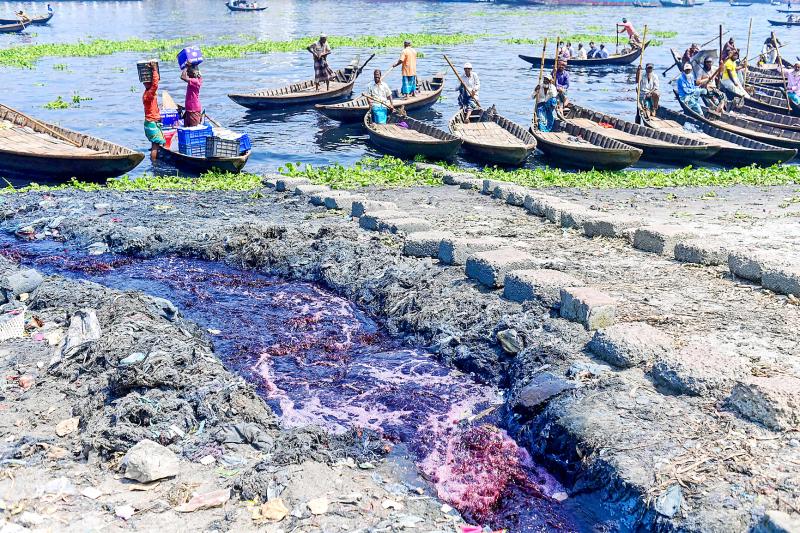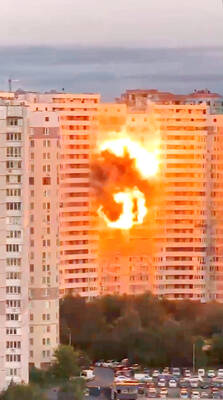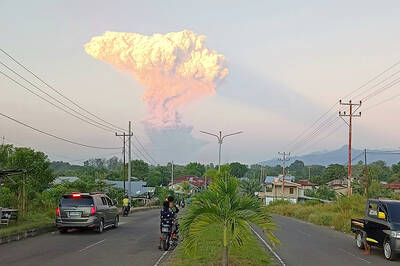Bangladeshi ferryman Kalu Molla began working on the Buriganga River before the patchwork of slums on its banks gave way to garment factories — and before its waters turned pitch black.
The 52-year-old has a constant cough, allergies and skin rashes, and doctors have told him the vile-smelling sludge that has also wiped out marine life in one of Dhaka’s main waterways is to blame.
“Doctors told me to leave this job and leave the river, but how is that possible?” Molla said near his home on the industrial outskirts of the capital, Dhaka. “Ferrying people is my bread and butter.”

Photo: AFP
In the half a century since a devastating independence war left its people facing starvation, Bangladesh has emerged as an often unheralded economic success story.
The South Asian nation of 169 million has overtaken its neighbor India in per capita income and will soon graduate from the UN’s list of the world’s least developed countries.
Underpinning years of runaway growth is the booming garment trade, servicing global fast-fashion powerhouses, employing millions of women and accounting for about 80 percent of the nation’s US$50 billion annual exports, but environmentalists say the growth has come at an incalculable cost, with a toxic melange of dyes, tanning acids and other dangerous chemicals making their way into the water.
Dhaka was founded on the banks of the Buriganga River more than 400 years ago by the Mughal empire.
“It is now the largest sewer of the country,” said Sheikh Rokon, the head of the Riverine People environmental rights group. “For centuries people built their homes on its banks to bask in the river breeze. Now the smell of toxic sludge during winter is so horrible that people have to hold their noses as they come near it.”
Water samples from the river found chromium and cadmium levels over six times the WHO’s recommended maximums, according to a 2020 paper by the Bangladeshi government’s River Research Institute.
Both elements are used in leather tanning and excessive exposure to either is extremely hazardous to human health — chromium is carcinogenic, while chronic cadmium exposure causes lung damage, kidney disease and premature births.
Ammonia, phenol and other byproducts of fabric dyeing have also helped to starve the river of the oxygen needed to sustain marine life.
In Shyampur, one of several sprawling industrial districts around Dhaka, locals said that at least 300 local factories were discharging untreated wastewater into the Buriganga River.
Residents say they have given up complaining about the putrid smell of the water, knowing that offending businesses are easily able to shirk responsibility.
“The factories bribe [authorities] to buy the silence of the regulators,” said Chan Mia, who lives in the area. “If someone wants [to] raise the issue to the factories, they’d beat them up. They are powerful people with connections.”
The crucial position of the textile trade in the economy has created a nexus between business owners and the nation’s political establishment. In some cases, politicians themselves have become powerful industry players.
Further south, in Narayanganj District, residents showed a stream of crimson-colored water draining into stagnant canals from a nearby factory.
“But you cannot say a word about it loudly,” a resident said, speaking on condition of anonymity. “We only suffer in silence.”
The Bangladesh Garment Manufacturers and Exporters Association (BGMEA), which represents the interests of about 3,500 top factories, defends its record by pointing out the environmental certifications given out to its members.
“We are going green — that’s why we are witnessing big jumps in export orders,” BGMEA president Faruque Hassan told a recent news conference.
However, smaller factories and sub-contractors operating on the industry’s razor thin margins say they are unable to afford the cost of wastewater treatment.
A top garment official in the Savar industrial district, speaking on condition of anonymity, said even most high-end factories serving major US and European brands often do not turn on their treatment machinery.
“Not everyone regularly uses it. They want to save costs,” he said.
Bangladesh is crisscrossed by more than 200 waterways, each of them connected to the mighty Ganges and Brahmatura rivers that course from the Himalayas and through the South Asian subcontinent.
More than one-quarter of them are now heavily contaminated with industrial pollutants and need to be “urgently” saved, said an April legal notice sent to the government by the Bangladesh Environmental Lawyers Association.
Authorities have established a commission tasked with saving key water bodies, upon which close to half the nation’s population depend for farming, while the National River Commission has launched several high profile drives to fine factories found to have polluted rivers.
Its newly appointed chief, Manjur Chowdhury, said “greedy” industrialists were to blame for the state of the nation’s waterways, but he also admitted that the enforcement of existing penalties was inadequate to address the scale of the problem.
“We have to frame new laws to face this emergency situation, but it will take time,” he said.
Any action will be too late for the five rivers that circle Dhaka and its industrial outskirts.
All are already technically dead, meaning they are completely devoid of marine life, environmentalist Sharif Jamil said.
“With factories now moving deep into the rural heartland, rivers across the country are facing the same fate,” he said.

Former Nicaraguan president Violeta Chamorro, who brought peace to Nicaragua after years of war and was the first woman elected president in the Americas, died on Saturday at the age of 95, her family said. Chamorro, who ruled the poor Central American country from 1990 to 1997, “died in peace, surrounded by the affection and love of her children,” said a statement issued by her four children. As president, Chamorro ended a civil war that had raged for much of the 1980s as US-backed rebels known as the “Contras” fought the leftist Sandinista government. That conflict made Nicaragua one of

COMPETITION: The US and Russia make up about 90 percent of the world stockpile and are adding new versions, while China’s nuclear force is steadily rising, SIPRI said Most of the world’s nuclear-armed states continued to modernize their arsenals last year, setting the stage for a new nuclear arms race, the Stockholm International Peace Research Institute (SIPRI) said yesterday. Nuclear powers including the US and Russia — which account for about 90 percent of the world’s stockpile — had spent time last year “upgrading existing weapons and adding newer versions,” researchers said. Since the end of the Cold War, old warheads have generally been dismantled quicker than new ones have been deployed, resulting in a decrease in the overall number of warheads. However, SIPRI said that the trend was likely

BOMBARDMENT: Moscow sent more than 440 drones and 32 missiles, Volodymyr Zelenskiy said, in ‘one of the most terrifying strikes’ on the capital in recent months A nighttime Russian missile and drone bombardment of Ukraine killed at least 15 people and injured 116 while they slept in their homes, local officials said yesterday, with the main barrage centering on the capital, Kyiv. Kyiv City Military Administration head Tymur Tkachenko said 14 people were killed and 99 were injured as explosions echoed across the city for hours during the night. The bombardment demolished a nine-story residential building, destroying dozens of apartments. Emergency workers were at the scene to rescue people from under the rubble. Russia flung more than 440 drones and 32 missiles at Ukraine, Ukrainian President Volodymyr Zelenskiy

Indonesia’s Mount Lewotobi Laki-Laki yesterday erupted again with giant ash and smoke plumes after forcing evacuations of villages and flight cancelations, including to and from the resort island of Bali. Several eruptions sent ash up to 5km into the sky on Tuesday evening to yesterday afternoon. An eruption on Tuesday afternoon sent thick, gray clouds 10km into the sky that expanded into a mushroom-shaped ash cloud visible as much as 150km kilometers away. The eruption alert was raised on Tuesday to the highest level and the danger zone where people are recommended to leave was expanded to 8km from the crater. Officers also